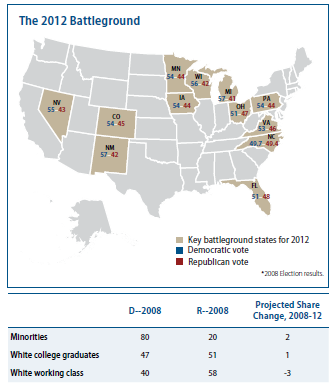Download this report (pdf)
Download the executive summary (pdf)
Washington, D.C. — The Center for American Progress today released a report analyzing demographic and geographic trends that will affect the increasingly competitive 2012 presidential election. The report, "The Path to 270: Demographics versus Economics in the 2012 Presidential Election," is authored by Senior Fellows and Co-Directors of the Progressive Studies Program at American Progress Ruy Teixeira and John Halpin.
The report analyzes the two large forces that will ultimately determine which side can reach 270 electoral votes in 2012: the shifting demographic balance of the American electorate, and the objective reality and voter perception of the economy in the key battleground states of the Midwest/Rust Belt (Iowa, Michigan, Minnesota, Ohio, Pennsylvania, and Wisconsin), the Southwest (Colorado, Nevada, and New Mexico), and the New South (Florida, North Carolina, and Virginia).
Teixeira and Halpin tackle the central questions of this election: Will the rising electorate of communities of color, the Millennial generation, professionals, single women, and seculars that pushed President Barack Obama to victory in 2008 continue to support him, and will they be galvanized to action to ensure his reelection? Or will the Republican Party and its presidential nominee capitalize on a struggling economy and greater mobilization from a conservative base that holds the president in deep disdain?

Key regional findings of the report include:
- The Midwest/Rust Belt (Iowa, Michigan, Minnesota, Ohio, Pennsylvania, and Wisconsin) region has been marked by a slow growth in voters from communities of color yet its growing white college-graduate population may help carry these states for President Obama in 2012. The outcome here will depend heavily on whether people’s perception of the economy improves.
- The Southwest (Colorado, Nevada, and New Mexico) region has a strong base of minority voters, chiefly Hispanic. These states are projected to average around 36 percent minority voters in 2012 and have a growing white college-graduate population that can also help President Obama. White working-class voters in the Southwest, however, are friendlier to the GOP, marking it a potentially fertile region for Republicans in 2012.
- The New South (Florida, North Carolina, and Virginia) has experienced strong growth driven by minority populations. In fact, these states are projected to average around 31 percent minority voters in 2012. In contrast to other regions, however, white college-graduate voters are more supportive of GOP candidates making this region a likely toss-up between President Obama and Republicans.
On a national level, given solid but not exceptional performance among minority voters, President Obama’s reelection depends on either holding his 2008 white college-graduate support, in which case he can survive a landslide defeat of 2010 proportions among white working-class voters or holding slippage among both groups to around 2004 levels. Furthermore, this report shows how Republicans likely cannot win with their base alone and instead need to find a way to cut into the president’s support among Latinos, professionals, Millennial generation voters, and moderates. Republicans can maximize their chances of appealing to disaffected Obama voters and more moderate Americans by focusing almost exclusively on the economy and downplaying their more divisive positions on religion, social issues, immigration, and the more extreme Tea Party positions.
Download this report (pdf)
Download the executive summary (pdf)
To speak to the authors of this report, please contact Laura Pereyra at 202.741.6258 or [email protected].
###